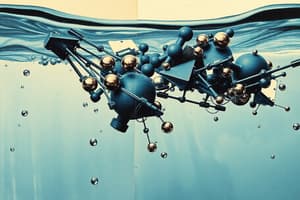Podcast
Questions and Answers
What type of electrical charge does the oxygen atom carry in a water molecule?
What type of electrical charge does the oxygen atom carry in a water molecule?
- No charge
- Fully negative
- Partially positive δ+
- Partially negative δ- (correct)
What property of water is a result of the polarity of water molecules?
What property of water is a result of the polarity of water molecules?
- High boiling point (correct)
- High viscosity
- Low density
- Lack of attraction between molecules
What term describes the phenomenon where water molecules are attracted to one another due to their polarity?
What term describes the phenomenon where water molecules are attracted to one another due to their polarity?
- Adhesion
- Diffusion
- Hydrophobic interactions
- Cohesion (correct)
Which characteristic of hydrogen bonds is true?
Which characteristic of hydrogen bonds is true?
Which statement regarding the partial charges in a water molecule is accurate?
Which statement regarding the partial charges in a water molecule is accurate?
What term describes molecules that are attracted to water?
What term describes molecules that are attracted to water?
What happens to hydrophobic molecules in water?
What happens to hydrophobic molecules in water?
In pure water, what is the relationship between hydrogen and hydroxide ions?
In pure water, what is the relationship between hydrogen and hydroxide ions?
What role does water play in relation to polar molecules and ions?
What role does water play in relation to polar molecules and ions?
What is the dissociation reaction of water?
What is the dissociation reaction of water?
What is cohesion in relation to water molecules?
What is cohesion in relation to water molecules?
What is the significance of water's high specific heat?
What is the significance of water's high specific heat?
How does water exhibit adhesion?
How does water exhibit adhesion?
Why is solid water less dense than liquid water?
Why is solid water less dense than liquid water?
What does it mean when we say that bodies of water freeze from the top down?
What does it mean when we say that bodies of water freeze from the top down?
Which pH value is typically associated with pure water?
Which pH value is typically associated with pure water?
What is the definition of an acid in aqueous solution?
What is the definition of an acid in aqueous solution?
What effect do buffers have on pH when an acid is added?
What effect do buffers have on pH when an acid is added?
Which of the following is an example of a base?
Which of the following is an example of a base?
In a basic solution, the concentration of H⁺ compared to OH⁻ is characterized by which relationship?
In a basic solution, the concentration of H⁺ compared to OH⁻ is characterized by which relationship?
Which of the following pH values represents a basic solution?
Which of the following pH values represents a basic solution?
Which of the following compounds dissociates to produce H⁺ ions in solution?
Which of the following compounds dissociates to produce H⁺ ions in solution?
What happens to proteins when the pH is too high or too low?
What happens to proteins when the pH is too high or too low?
Which example is associated with an acidic solution?
Which example is associated with an acidic solution?
What type of solution would lemon juice be classified as?
What type of solution would lemon juice be classified as?
What can happen if there is too much or too little H+ in a biological system?
What can happen if there is too much or too little H+ in a biological system?
What is the normal blood pH range that must be maintained in organisms?
What is the normal blood pH range that must be maintained in organisms?
What is the role of bicarbonate ion in the buffering system?
What is the role of bicarbonate ion in the buffering system?
Which reaction correctly represents the carbonic acid-bicarbonate buffering system?
Which reaction correctly represents the carbonic acid-bicarbonate buffering system?
What might result from the pH levels falling outside the range of 7.35 - 7.45?
What might result from the pH levels falling outside the range of 7.35 - 7.45?
Flashcards
Polarity of water molecule
Polarity of water molecule
Uneven distribution of charge within a water molecule.
Electro-negativity of Oxygen
Electro-negativity of Oxygen
Oxygen attracts electrons more strongly than hydrogen in a water molecule.
Partial charges in water
Partial charges in water
Oxygen becomes slightly negative (δ-) and hydrogen slightly positive (δ+).
Hydrogen bond in water
Hydrogen bond in water
Signup and view all the flashcards
Cohesion in Water
Cohesion in Water
Signup and view all the flashcards
What is an acid?
What is an acid?
Signup and view all the flashcards
What is a base?
What is a base?
Signup and view all the flashcards
Acidic solution
Acidic solution
Signup and view all the flashcards
Basic solution
Basic solution
Signup and view all the flashcards
HCl dissociation
HCl dissociation
Signup and view all the flashcards
Adhesion
Adhesion
Signup and view all the flashcards
High specific heat
High specific heat
Signup and view all the flashcards
High heat of vaporization
High heat of vaporization
Signup and view all the flashcards
Solid water less dense than liquid
Solid water less dense than liquid
Signup and view all the flashcards
Bodies of water freeze from the top down
Bodies of water freeze from the top down
Signup and view all the flashcards
Water is a good solvent
Water is a good solvent
Signup and view all the flashcards
Hydrophilic
Hydrophilic
Signup and view all the flashcards
Hydrophobic
Hydrophobic
Signup and view all the flashcards
Water's effect on nonpolar molecules
Water's effect on nonpolar molecules
Signup and view all the flashcards
pH of pure water
pH of pure water
Signup and view all the flashcards
pH Scale
pH Scale
Signup and view all the flashcards
Acidic
Acidic
Signup and view all the flashcards
Basic (Alkaline)
Basic (Alkaline)
Signup and view all the flashcards
Buffer
Buffer
Signup and view all the flashcards
Biological Buffers
Biological Buffers
Signup and view all the flashcards
pH in Organisms
pH in Organisms
Signup and view all the flashcards
Protein Denaturation
Protein Denaturation
Signup and view all the flashcards
Blood pH
Blood pH
Signup and view all the flashcards
What does the bicarbonate buffer system do?
What does the bicarbonate buffer system do?
Signup and view all the flashcards
Why is buffer system important?
Why is buffer system important?
Signup and view all the flashcards





